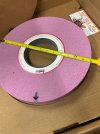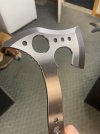One problem knife makers will eventually run into is stock thickness.
What we have seen is different batches of steel even (if from the same mill) will have different thicknesses. This is more pronounced when switching from say a 3V to a Z-Tuff or from a AEB-L to a 80crv2.
The thicker the steel the more variation you will see and at some point this can cause problems.
- Kydex being too tight or too loose
- Threaded hardware bottoming out.
- Milled blades with uneven machining
- CNC bevel grinding being to high or too low.
What gets companies in trouble is say they spec a blade at .187" and the steel has always been coming in at that thickness. So they make up a bunch of sheaths ahead of time that will take a blade .200" thick... But the steel comes in at .206" and they always skipped grinding because they "never" needed to worry about it. Now they have sheaths that don't fit and instead of sending the blades back they ask the sheath maker to remake the sheaths because sheaths are cheaper than blades.
Or say the process is blade milling.... and the same thing happened.... Steel always came in at .187" but now its at .206"..... if the machinist is good he'll notice this before he screws up a part.... If he's OK he will machine one part and notice the bevels look off on one side. If he goes to correct this without reprogramming the parts. Edge thickness just went up .019" and the sharpener has a big problem but the machinist isn't a knife maker so he figures this isn't a big deal.
The point is without some type of control on material thickness big problems can arise and can be quite expensive. If you are handmaking small batches most people ignore this step and can generally do so without problems. If your leaning towards production oriented blades or mid-tech blades this is something you want to seriously consider.
There are 3 generally accepted methods of grinding blades to thickness:
- Double Disk.... this is generally the best method..... the only problem here is they will have restrictions on steel types, blade shapes and want part quantities. These type of machines are somewhat rare and finding a quality grind shop with one can be a challenge.
- Blanchard..... They will remove a LOT of material very quickly! This can be a good thing or catastrophically bad when they overheat your knife steel. I'm told they need minimum amount of cut around .005-.010 per side so if you just need a little clean up they don't work.
- Surface Grinding... This is generally a good option, with a good surface finish, very good tolerance and medium stock removal.
We are running an Amada D3 Techster which is the fanciest surface grinder I've seen in any knife shop and by a large margin. The advantage on this one is everything is cnc controlled, so depth of cut, width of cut, oscillating speed, and complicated dressing cycles are all fully programmable. So we can rough something out faster than most surface grinders then put on nice finish. Say there is 200 blades to grind.... load up the first 20 knifes and watch the cycle... if the parts are the correct thickness and the surface finish is good.... simply load up the next 20 and check one out of every batch. Now the machinist can do something else and this is a lot harder to do with hydraulic surface grinders.
Our capacity is 12"X24" and in theory accuracy is 4 times smaller than human blood cell (.00001) which no knife maker needs. So what I tend to do is worry more about the surface finish than the tolerance and being a 9000 lb monster it tends to put on a nicer surface finish than it should. (I'll post some photos at a later date). For my own parts I'll just aim for +/-.0005 on the first load then adjust it. If we are holding .00025" that's plenty good enough.
If this is a service you are interested in please inquire. Steels have to be magnetic. How many parts fit on the chuck and how much material is being removed pretty much dictate the price.
What we have seen is different batches of steel even (if from the same mill) will have different thicknesses. This is more pronounced when switching from say a 3V to a Z-Tuff or from a AEB-L to a 80crv2.
The thicker the steel the more variation you will see and at some point this can cause problems.
- Kydex being too tight or too loose
- Threaded hardware bottoming out.
- Milled blades with uneven machining
- CNC bevel grinding being to high or too low.
What gets companies in trouble is say they spec a blade at .187" and the steel has always been coming in at that thickness. So they make up a bunch of sheaths ahead of time that will take a blade .200" thick... But the steel comes in at .206" and they always skipped grinding because they "never" needed to worry about it. Now they have sheaths that don't fit and instead of sending the blades back they ask the sheath maker to remake the sheaths because sheaths are cheaper than blades.
Or say the process is blade milling.... and the same thing happened.... Steel always came in at .187" but now its at .206"..... if the machinist is good he'll notice this before he screws up a part.... If he's OK he will machine one part and notice the bevels look off on one side. If he goes to correct this without reprogramming the parts. Edge thickness just went up .019" and the sharpener has a big problem but the machinist isn't a knife maker so he figures this isn't a big deal.
The point is without some type of control on material thickness big problems can arise and can be quite expensive. If you are handmaking small batches most people ignore this step and can generally do so without problems. If your leaning towards production oriented blades or mid-tech blades this is something you want to seriously consider.
There are 3 generally accepted methods of grinding blades to thickness:
- Double Disk.... this is generally the best method..... the only problem here is they will have restrictions on steel types, blade shapes and want part quantities. These type of machines are somewhat rare and finding a quality grind shop with one can be a challenge.
- Blanchard..... They will remove a LOT of material very quickly! This can be a good thing or catastrophically bad when they overheat your knife steel. I'm told they need minimum amount of cut around .005-.010 per side so if you just need a little clean up they don't work.
- Surface Grinding... This is generally a good option, with a good surface finish, very good tolerance and medium stock removal.
We are running an Amada D3 Techster which is the fanciest surface grinder I've seen in any knife shop and by a large margin. The advantage on this one is everything is cnc controlled, so depth of cut, width of cut, oscillating speed, and complicated dressing cycles are all fully programmable. So we can rough something out faster than most surface grinders then put on nice finish. Say there is 200 blades to grind.... load up the first 20 knifes and watch the cycle... if the parts are the correct thickness and the surface finish is good.... simply load up the next 20 and check one out of every batch. Now the machinist can do something else and this is a lot harder to do with hydraulic surface grinders.
Our capacity is 12"X24" and in theory accuracy is 4 times smaller than human blood cell (.00001) which no knife maker needs. So what I tend to do is worry more about the surface finish than the tolerance and being a 9000 lb monster it tends to put on a nicer surface finish than it should. (I'll post some photos at a later date). For my own parts I'll just aim for +/-.0005 on the first load then adjust it. If we are holding .00025" that's plenty good enough.
If this is a service you are interested in please inquire. Steels have to be magnetic. How many parts fit on the chuck and how much material is being removed pretty much dictate the price.




